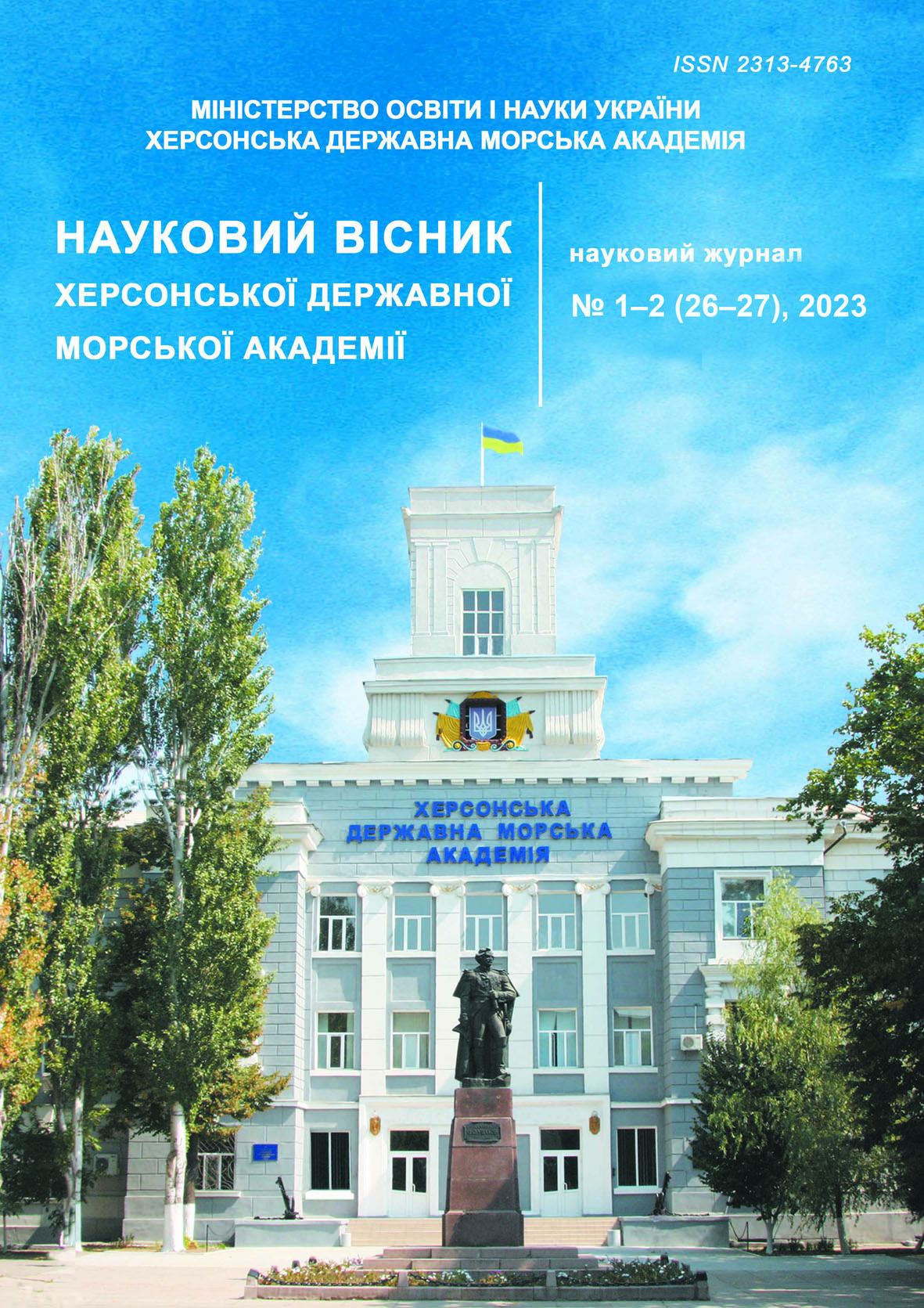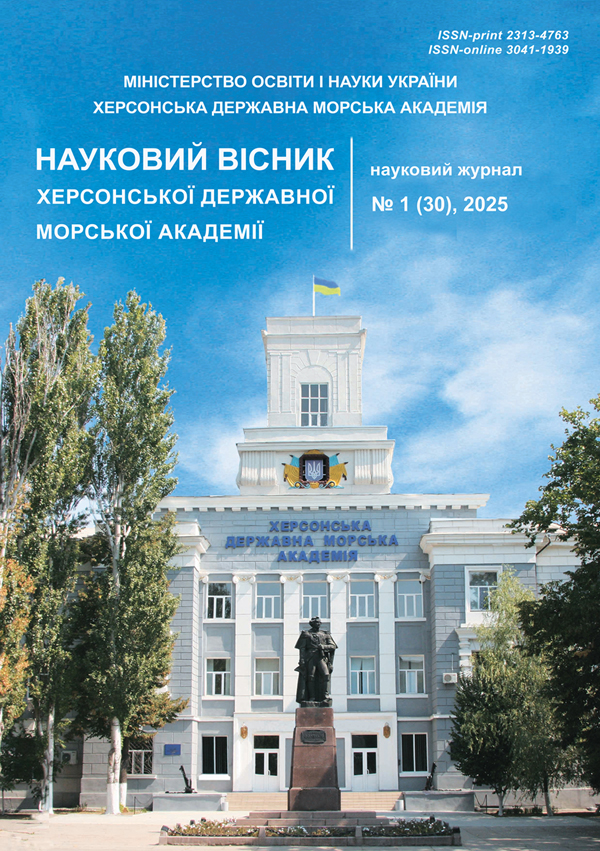FORMATION OF THE SHIP'S OBSERVATION ACCURACY FIELD USING MULTIPLE LANDMARKS
https://doi.org/10.33815/2313-4763.2025.1.30.069-079
Abstract
Abstract. This paper highlights the fact that the presence of navigational obstacles, such as shoals, significantly increases the risk of maritime accidents when vessels operate in confined or restricted waters. Such obstacles create unpredictable conditions where the margin for navigational error is minimal. Errors in navigational measurements, as well as inaccuracies in ship maneuvering, contribute to heightened risks of grounding, collision, and close-quarter situations. In areas with high traffic density, the danger is further amplified, increasing the likelihood of navigational conflicts and incidents.
A particularly critical factor affecting navigational safety, especially in zones with unreliable reception of satellite navigation signals, is the accuracy of determining a vessel’s position using traditional navigation landmarks. In such cases, reliance on visual or radar-based observation becomes essential. Therefore, it is important to assess how accurately the position of a ship can be determined when using multiple fixed landmarks.
To develop an observation accuracy field for a vessel, based on several landmarks, a scalar accuracy measure is applied to each point within the coastal navigation area. The most appropriate measure for this purpose is the dispersion of the modulus of the vector error. This measure provides a quantitative indicator of how precisely the vessel’s location can be determined based on the geometry and accuracy of the observations.
An analytical expression for the accuracy index is presented for cases involving distance and bearing measurements to each landmark, assuming normally distributed errors along position lines. To visualize the field of observation accuracy across a navigational area, a computer simulation model was created.
The scalar accuracy index was calculated for scenarios involving two, three, and four landmarks. The index value influences the degree of shading applied to each grid section in the accuracy field, darker shading corresponds to higher accuracy indices. The resulting accuracy field can be digitized and displayed on an electronic chart, offering mariners a visual representation of positional confidence throughout the area.
References
2. Benedict, K., Kirchhoff, M., Gluch, M., Fischer, S., Baldauf, M. (2009). Maneuvering Simulation on the Bridge for Predicting Motion of Real Ships and as Training Tool in Ship Handling Simulators, TransNav, International magazine on marine navigation and safety of marine transport, Vol. 3, nn. 1, pp. 25–30.
3. Shi, C. J., Zhao, D., Peng, J., Shen, C. (2009). Identification of Ship Maneuvering Model Using Extended Kalman Filters, TransNav, International magazine on marine navigation and safety of marine transport, Vol. 3,nn. 1, pp. 105–110.
4. Benedict, K., Kirchhoff, M., Gluch, M., Fischer, S., Schaub, M., Baldauf, M., Klaes, S. (2014). Simulation Augmented Manoeuvring Design and Monitoring – a New Method for Advanced Ship Handling, TransNav, International magazine on marine navigation and safety of marine transport, Vol. 8, nn. 1, https://doi.org/10.12716/1001.08.01.15, pp. 131–141.
5. Kalinichenko, Y. V. (2014). Accounting for turning characteristics when calculating vessel turning parameters, Vodniy tranport. №2 (20), pp. 63–67.
6. Kalinichenko, Y. V. (2014). Ensuring the required accuracy of vessel turning by moving its curved trajectory, Avtomatizatsiya sudovyh tehnicheskih sredstv, № 20, pp. 52–58, 2014.
7. Kalinichenko, Y., Burmaka, I. (2016). Analysis of mathematical models of changing the vessel's course when turning, Eastern-European Journal of Enterprise Technologies, 6/9(84), https://doi.org/10.15587/1729-4061.2016.85839, pp. 20–31.
8. Vorokhobin, I. I., Каzак, Y. V., Severin, V. V. (2018). Assessment of navigation safety when vessels are sailing in confined waters. Saarbrucken, Deutschland: LAP LAMBERT Academic Publishing.
9. Severin, V. V. (2017). Assessment of the probability of safe vessel navigation along a confined route, Science and Education a New Dimension. Natural and Technical Sciences, V(16), Issue: 148, pp. 94–98.
10. Vorokhobin, I. I. (2018). The influence of the law of distribution of lateral deviation error on the probability of safe passage of a vessel along a confined route, East European Scientific Journal, №5 (33), pp. 30–37.
11. Vagushchenko, L. L. (2013). Divergence with vessels by shifting to a parallel track line, Odesa: Feniks, 2013.
12. Thomas Statheros, Gareth Howells, Klaus McDonald-Maier (2008). Autonomous ship collision avoidance navigation concepts, technologies and techniques, J. Navig., v. 61, nn. 1, pp. 129–142.
13. Vagushchenko, L., Vagushchenko, A. (2023). Graphical Tools to Facilitate the Selection of Manoeuvres to Avoid Collision, TransNav, the International Journal on Marine Navigation and Safety of Sea Transportation, Vol. 17, No. 3, https://doi.org/10.12716/1001.17.03.14, pp. 625–633.
14. Huang, Y., Chen, L., Chen, P., Negenborn, R. R. & P. H. van Gelder (2020). Ship collision avoidance methods: State-of-the-art, Safety Science, nn. 121, pp. 451–473.
15. Lazarowska, A. (2021). Review of Collision Avoidance and Path Planning Methods for Ships Utilizing Radar Remote Sensing, Remote Sens, nn.13, pp. 32–65.
16. Pyatakov, V. E., Petrychenko, О. А., Kalyuzhniy, V. V. (2018). Method of successive divergence of a vessel with two dangerous targets, Avtomatizatsiya sudovyh tehnicheskih sredstv, № 24. pp. 81–87.
17. Petrychenko, Е. А., Petrychenko, О. А. (2018). Development of a ship's information system for collision avoidance, Sudovozhdenie, Vyp. 28, pp. 120–130.
18. Martelli, M., Žuškin, S., Zaccone, R., Rudan, I. (2023). A COLREGs-Compliant Decision Support Tool to Prevent Collisions at Sea, TransNav, the International Journal on Marine Navigation and Safety of Sea Transportation, Vol. 17, No. 2, https://doi.org/10.12716/1001.17.02.11, pp. 347–353.
19. Mudrov, V. M., Kushko, V. L. (1976). Methods of treatment of measurings, M.: Sovetskoe radio.
20. Stepanenko, V. V. (2000). Efficiency of assessing the parameters of the situation of dangerous approach of ships, Sudovozhdenie, Vyp. 2, pp. 201–209.
21. Buzovsky, D. A. (2006). Dependence of the accuracy criterion of the reverse-type radar system on its structure, Sudovozhdenie, Vyp. 11, pp14–19.
22. Astayrin, D. V., Sikirin, V. E., Vorokhobin, I. I. and Alekseychuk, B. M. (2017). Estimation of exactness of coordinates of ship at the surplus measuring. Saarbrucken, Deutschland: LAP LAMBERT Academic Publishing.






